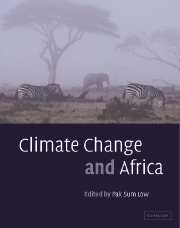Book contents
- Frontmatter
- Contents
- Notes on contributors
- Peer reviewers
- Editor's note
- Foreword
- Foreword
- Foreword
- Foreword
- Preface
- Preface
- Preface
- Preface
- List of abbreviations
- List of SI prefixes
- List of unit abbreviations
- List of chemical formulae
- Part I Science
- Part II Sustainable energy development, mitigation and policy
- 10 Biomass energy in sub-Saharan Africa
- 11 Natural resources: population growth and sustainable development in Africa
- 12 Sustainable energy development and the Clean Development Mechanism: African priorities
- 13 Opportunities for clean energy in the SADC under the UNFCCC: the case for the electricity and transport sectors
- 14 Regional approaches to global climate change policy in sub-Saharan Africa
- 15 Energy for development: solar home systems in Africa and global carbon emissions
- 16 Climate change in sub-Saharan Africa: assumptions, realities and future investments
- 17 Climate-friendly energy policies for Egypt's sustainable development
- Part III Vulnerability and adaptation
- Part IV Capacity-building
- Part V Lessons from the Montreal Protocol
- Index
14 - Regional approaches to global climate change policy in sub-Saharan Africa
Published online by Cambridge University Press: 10 December 2009
- Frontmatter
- Contents
- Notes on contributors
- Peer reviewers
- Editor's note
- Foreword
- Foreword
- Foreword
- Foreword
- Preface
- Preface
- Preface
- Preface
- List of abbreviations
- List of SI prefixes
- List of unit abbreviations
- List of chemical formulae
- Part I Science
- Part II Sustainable energy development, mitigation and policy
- 10 Biomass energy in sub-Saharan Africa
- 11 Natural resources: population growth and sustainable development in Africa
- 12 Sustainable energy development and the Clean Development Mechanism: African priorities
- 13 Opportunities for clean energy in the SADC under the UNFCCC: the case for the electricity and transport sectors
- 14 Regional approaches to global climate change policy in sub-Saharan Africa
- 15 Energy for development: solar home systems in Africa and global carbon emissions
- 16 Climate change in sub-Saharan Africa: assumptions, realities and future investments
- 17 Climate-friendly energy policies for Egypt's sustainable development
- Part III Vulnerability and adaptation
- Part IV Capacity-building
- Part V Lessons from the Montreal Protocol
- Index
Summary
Keywords
Global climate change policy; global climate change response strategies; regional cooperation; regional organizations; sub-Saharan Africa
Abstarct
This chapter examines the potential for different regional approaches in response to global climate change challenges in sub-Saharan Africa. Working together, governments, businesses, non-governmental organizations and/or other groups in two or more neighbouring countries could develop response strategies that would benefit both the global climate and local development in Africa. In this chapter, the following possible regional response strategies are presented and investigated: countries working together as a regional actor in international negotiations; regional strategies to adapt to global climate change; regional mitigation strategies; and the development of knowledge at the regional level. Of course, not every possible regional approach to global climate change policy will be desirable. Nevertheless, by presenting a broad range of possibilities, this chapter aims to stimulate interest in, and further research on, regional approaches to global climate change policy in sub-Saharan Africa.
INTRODUCTION
The purpose of this chapter is to examine the potential for different regional approaches in response to global climate change challenges in sub-Saharan Africa. The argument advanced is that it is in African decision makers' interests to complement the usual focus upon national approaches with a consideration of how regional approaches could be part of a broader portfolio of climate change responses. To investigate this potential, the chapter proceeds in five main sections.
- Type
- Chapter
- Information
- Climate Change and Africa , pp. 150 - 162Publisher: Cambridge University PressPrint publication year: 2005
- 2
- Cited by



